Homemade Pregnancy Test: Does It Really Work?
Try these out if you don't feel like heading to the drugstore just yet.
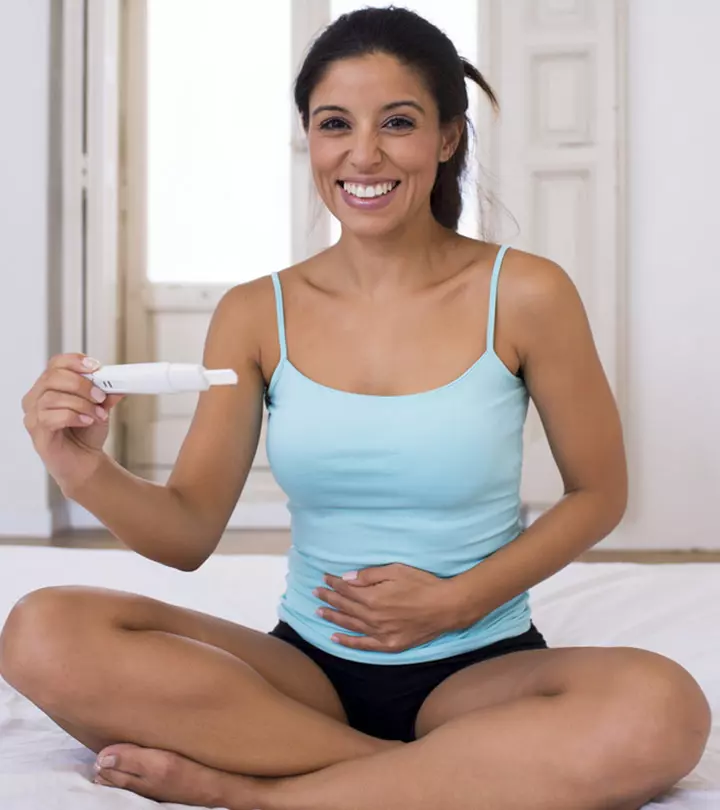
Image: Shutterstock
No matter how prepared you are, pregnancy can be daunting. This is particularly true if you think you may be pregnant but are not in a position to purchase a pregnancy kit immediately. A homemade pregnancy test is a good solution to this problem. While the results may not be accurate, they can give you an idea before consulting a doctor or purchasing a commercial test kit. Keep reading to discover more about homemade pregnancy tests and ways to use them.
In This Article
When To Take A Pregnancy Test
You must take a pregnancy test a week after you have missed your periods for the most accurate results. This duration must be maintained because the Human Chorionic Gonadotropin (HCG), a hormone for maternal recognition of pregnancy, appears in maternal blood after 6-8 days of implantation. The tests detect the presence of HCG in your urine to determine if you are pregnant (1).
If you don’t want to wait until your periods to know whether you are expecting or not, wait for at least a week or two after having had sex and retake the test. Repeat the test in a couple of days to reconfirm the results.
Also, do not drink too much water before a test to prevent diluting the urine. This may not give you accurate results. It is better to test your first urine in the morning. Keep reading to learn how to detect pregnancy with homemade tests.
Key Takeaways
- Homemade pregnancy tests may be made using salt, sugar, bleach, toothpaste, or other common pantry items in an emergency.
- These tests are based on anecdotal evidence and have not been studied in labs for their accuracy.
- These methods might be easy and cost-effective but it is best to take the test after a week of missed periods.
Best Homemade Pregnancy Tests
Note: All these tests are based on anecdotal evidence. We strongly recommend you to use a pregnancy kit and consult a doctor.
1. Urine Pregnancy Test
You Will Need
- ½ cup of urine
- A flat-surfaced container
What You Have To Do
- Collect half a cup of your first urine after waking up.
- Let it stand untouched for 24 hours.
How It May Work
After 24 hours, if you see a small frothy/ foamy layer on top, you might be pregnant. Anecdotal evidence suggests that a frothy layer may indicate the presence of the HCG (Human Chorionic Gonadotropin) hormone, which is usually secreted when you are pregnant.
 Quick Tip
Quick Tip2. Sugar Pregnancy Test
You Will Need
- 3 tablespoons of white sugar
- ½ cup of urine (first urine of the day)
- A plastic cup
What You Have To Do
- Put the sugar into a plastic cup and pour the urine into it.
- Wait for 5 to 10 minutes and observe.
How It May Work
If the sugar dissolves in the urine, you can rule out the chances of pregnancy. But if it begins to clump, it may be an indication of pregnancy. The presence of the HCG hormone in your urine may lead to the clumping of sugar.
3. Bleach Pregnancy Test

You Will Need
- ½ cup of bleach
- ½ cup of urine
- A plastic cup
What You Have To Do
- Collect half a cup of your first urine in the morning in a plastic cup.
- Cover your nose and mouth with a mask before handling the bleach to avoid inhaling its fumes.
- Wear gloves and pour bleach into a plastic cup.
- Pour the urine sample into the cup filled with bleach.
- Wait for about 5 minutes and observe.
How It May WorkAnecdotal evidence suggests that you might be pregnant if it foams or you observe any reaction/changes in the bleach.
The urine may react with bleach due to the presence of the HCG hormone. However, if there is no reaction, the result may be negative.
4. Toothpaste Pregnancy Test
You Will Need
- 2 tablespoons of morning urine
- A dollop of white toothpaste
- A plastic cup
What You Have To Do
- Put the toothpaste in a plastic cup.
- Pour the collected morning urine into it.
- Wait for 5 to 10 minutes.
How It May Work
It is believed that if the toothpaste turns light blue or becomes frothy, you might be pregnant. However, if there are no reactions and the toothpaste dissolves in the urine, the result might be negative.
5. Strips Pregnancy Test
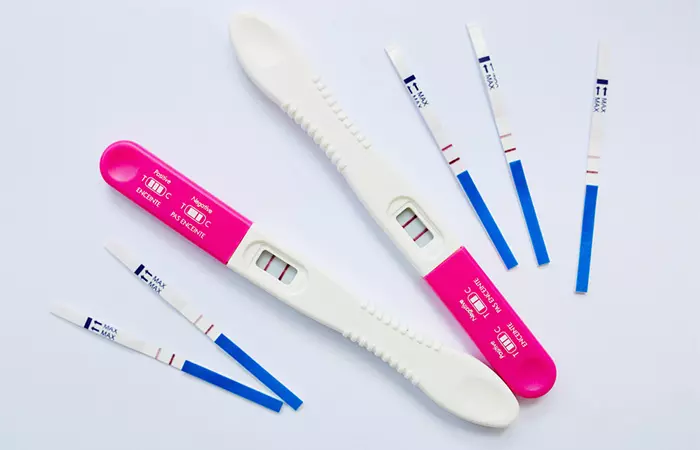
You Will Need
- ½ cup of urine
- HCG test strips
- A plastic cup
What You Have To Do
- Dip the HCG strip into the urine (the arrow must point towards the urine).
- Remove the strip after 3 seconds and place it on a clean, dry, and nonabsorbent surface.
- Read and check the results within 5 minutes.
How It May Work
Two colored lines on the strip indicate pregnancy, while a single line indicates a negative result. If there are no lines, the test is invalid and you have to try again.
 Quick Tip
Quick Tip6. Salt Pregnancy Test
You Will Need
- ½ cup of urine
- 2-3 tablespoons of salt
- A plastic cup
What You Have To Do
- Collect half a cup of your first urine in the morning.
- Add the salt to this and wait for about 5 minutes.
- Observe the mixture.
How It May WorkAnecdotal evidence suggests that clumped salt may be a sign of pregnancy.
This is because the salt reacts with the HCG hormone and clumps. However, if the salt dissolves without clumping, the test is negative.
7. Shampoo Pregnancy Test

You Will Need
- ½ cup of urine
- 1-2 tablespoons of shampoo
- A plastic cup
What You Have To Do
- Take two tablespoons of shampoo in a plastic cup.
- Pour the urine into this.
- Wait for 5 to 7 minutes and observe the urine.
How It May Work
If you observe any change in the color, it hints at a positive pregnancy. But in the absence of any such changes, the result may be probably negative. However, the exact mechanism or logic behind this test is unclear.
8. Soap Pregnancy Test
You Will Need
- 2 tablespoons of morning urine
- A small piece of soap
- A plastic cup
What You Have To Do
- Place the soap in a plastic cup.
- Pour the morning urine into the cup.
- Observe the cup after 5 minutes.
How It May Work
It is said that when the HCG hormone comes in contact with the soap, it may react and form bubbles or froth, which indicates a probable pregnancy. But in the absence of this hormone, the soap will not changes and remain intact, thus indicating a negative result.
9. Vinegar Pregnancy Test

You Will Need
- 1½ cups of morning urine
- 1 cup of vinegar
- A plastic cup
What You Have To Do
- Pour a cup of vinegar into a plastic cup.
- Add the urine to it.
- Allow it to stand for about 5 minutes and observe.
How It May WorkAnecdotal evidence suggests that vinegar changes color on reacting with the HCG hormone in the urine if you are pregnant.
But if it doesn’t change color, it rules out chances of pregnancy.
10. Dandelion Pregnancy Test

You Will Need
- ½ cup of morning urine
- 2-3 fresh dandelion leaves
- A wide container
What You Have To Do
Place the dandelion leaves in the urine and observe them after 10 minutes.
How It May Work
It is believed that the dandelion leaves may develop red marks after reacting with HCG, indicating pregnancy. However, if they do not change color, you may not be pregnant.
11. Pregnancy Test Using A Basal Body Thermometer
You Will Need
A basal body thermometer
What You Have To Do
- Check your basal body temperature immediately after waking up in the morning.
- Place it under your tongue for a few seconds.
- Check the reading.
How It May Work
It is said that if the thermometer shows a basal body temperature of 98.6°F or 37°C, there is a chance that you may be pregnant. The basal body temperature usually increases during ovulation and decreases if you don’t conceive. But if you are pregnant, it continues to remain high.
The above-mentioned homemade pregnancy tests are quite simple but may not be very effective. They are not backed by any scientific research. Hence, one should be mindful of the reliability and sensitivity of these tests. So, if you think you are pregnant, it is better to check using a pregnancy kit and consult a doctor. Listed below are some tips for taking a pregnancy test.
Tips For Pregnancy Test
- Choose a reliable and well-known brand when purchasing a pregnancy test to get accurate results. Digital tests often provide clear results.
- For the most accurate results, wait until your period is at least a day late before taking the test. Testing too early may lead to a false negative result.
- For the test, use the urine from the first time you pee in the morning. It is more concentrated and has larger quantities of the pregnancy hormone hCG and is, hence, more likely to provide an accurate result.
- Ensure the test kit has not expired. Expired tests may not provide accurate results.
- Refrain from drinking excessive fluids before the test as it can dilute the hCG hormone in your urine.
- Stress and anxiety may affect your body, potentially impacting the results. Therefore, stay calm and relaxed during the testing process.
What To Do After Taking A Home Pregnancy Test
If you test negative for pregnancy but have not yet got your periods, you must:
- Wait for a week and retake the pregnancy test to rule out the chances of pregnancy.
- Take a pregnancy test first thing in the morning for best results. But can you pee in a cup and test for pregnancy? Yes, you can.
- Wait for your periods to arrive. Sometimes, they might be delayed because of an underlying medical condition like PCOS.
- If you have not got your periods even after a month or two, and you still test negative for pregnancy, consult your doctor.
- During pregnancy, women may also experience bleeding. You should talk to your gynecologist about when bleeding is normal and when it is a cause for concern.
If your pregnancy test is positive, here is what you should be doing:
- First and foremost, you must visit your doctor to confirm your pregnancy and get an ultrasound test done.
- The next thing you must do is calculate the due date of your baby and start preparing. Follow the doctor’s advice to maintain your overall health and care for the fetus.
- Wait until you complete the first three months before you reveal your pregnancy to your extended family, as it becomes stable only after the first trimester.
- Give up unhealthy habits like smoking and drinking.
- Indulge in healthy habits like some mild pregnancy-safe workouts. Also, pay extra attention to your diet.
You need to work with your doctor throughout the pregnancy to ensure the journey is safe for you and the child. Here are some early signs to check out for during pregnancy.
Early Signs And Symptoms Of Pregnancy
When you are pregnant, your body experience changes, and as a result, you may experience:
- Tender and swollen breasts
- Fatigue and tiredness
- Cramping
- Nausea
- Vomiting
- Food cravings or aversions
- Frequent headaches
- Constipation
- Mood swings
- Dizziness
- Increased basal body temperature
- Missed periods
Kelly, a blogger, candidly shared insights into some early signs of pregnancy in her blog. She revealed, “Morning sickness for me was a total misnomer, being constantly uncomfortable during the day (i).”
Although these symptoms are natural and have been observed in many pregnant women, they might also occur when you are about to get your periods (PMS) or could even be an indication of an underlying condition. It is best to consult a doctor and get yourself tested.
Infographic: 5 Most Popular Homemade Pregnancy Tests
Pregnancy requires a great deal of preparation, both physical and mental. Thus, when the kit is not around to confirm it, some people resort to anecdotal methods that are purported to provide a quick solution. The infographic lists down 5 such homemade pregnancy tests. Scroll down and take a look on how to check for pregnancy at home naturally!

Illustration: StyleCraze Design Team
These homemade or DIY pregnancy tests are not foolproof methods but based on anecdotal evidence. These tests can be an alternative option and may not be accurate, but they provide an outlet for you to check if you are pregnant. Although there is no risk in experimenting with these measures, you should not rely on their outcomes. We highly recommend you consult your healthcare provider and take a pregnancy test as advised by them. This will help you assess your situation promptly and follow the right medical advice to ensure a safe and healthy pregnancy.
Frequently Asked Questions
What is a finger test in pregnancy?
The finger test in pregnancy refers to checking for the firmness of your cervix by inserting your finger through the vaginal opening. The cervix should feel firm to the touch if you are not pregnant and soft if you are pregnant. In addition, your cervix may be at a higher position if you have conceived as opposed to being lower as is usual before menstruation.
How does a pregnant belly feel in early pregnancy?
Your belly may feel rounded, bloated, and full due to the effect of progesterone, a pregnancy hormone.
What does early pregnancy discharge look like?
Early pregnancy discharge may look like pale-yellow mucus, or it may look sticky or white.
What part of your stomach hurts in early pregnancy?
The lower portion of the stomach may hurt during the first trimester of pregnancy.
When do most pregnancy symptoms start?
Some pregnancy symptoms start within a few days of conception whereas other early symptoms may begin after around a week from conception.
Can I take a pregnancy test at night?
Yes, you may take a pregnancy test at night. However, it is advisable to take it early in the morning as the pregnancy hormone may be present in the urine in higher concentrations at that time.
Illustration: Homemade Pregnancy Test: Does It Really Work?

Image: Dall·E/StyleCraze Design Team
Click on the video below and learn how to confirm pregnancy without taking a test. Get tips on recognizing signs and symptoms, and find out what careful measures to take next.
Personal Experience: Source
StyleCraze's articles are interwoven with authentic personal narratives that provide depth and resonance to our content. Below are the sources of the personal accounts referenced in this article.
i. Things I didn’t know about Pregnancy (1st trimester)https://pilatesandprints.wordpress.com/2020/08/09/things-i-didnt-know-about-pregnancy-1st-trimester/
References
Articles on StyleCraze are backed by verified information from peer-reviewed and academic research papers, reputed organizations, research institutions, and medical associations to ensure accuracy and relevance. Read our editorial policy to learn more.
- Pregnancy tests: a review
https://pubmed.ncbi.nlm.nih.gov/1639991/
Read full bio of Dr. Bhawna Agarwal
Read full bio of Shaheen Naser
Read full bio of Arshiya Syeda
Read full bio of Dipti Sharma








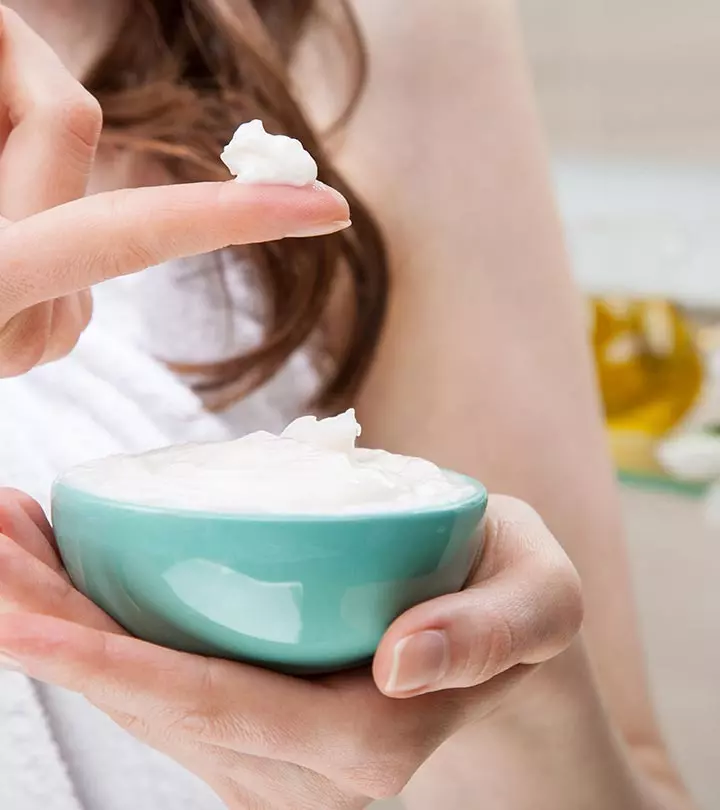












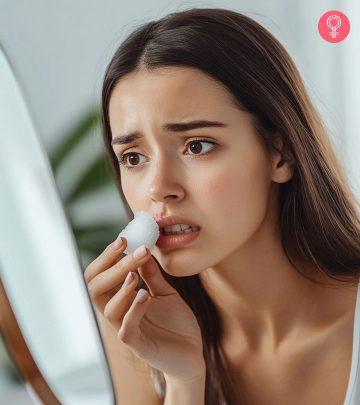
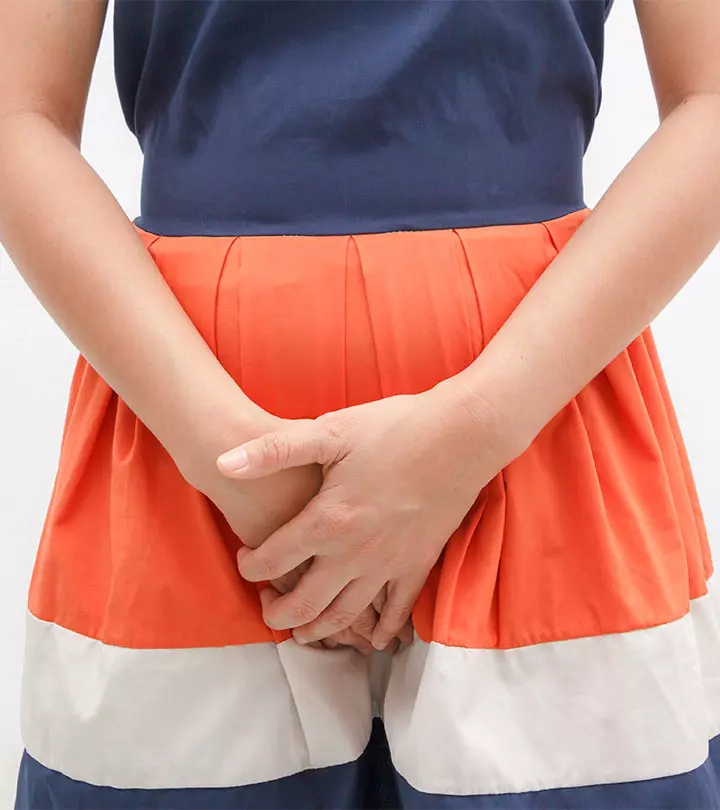
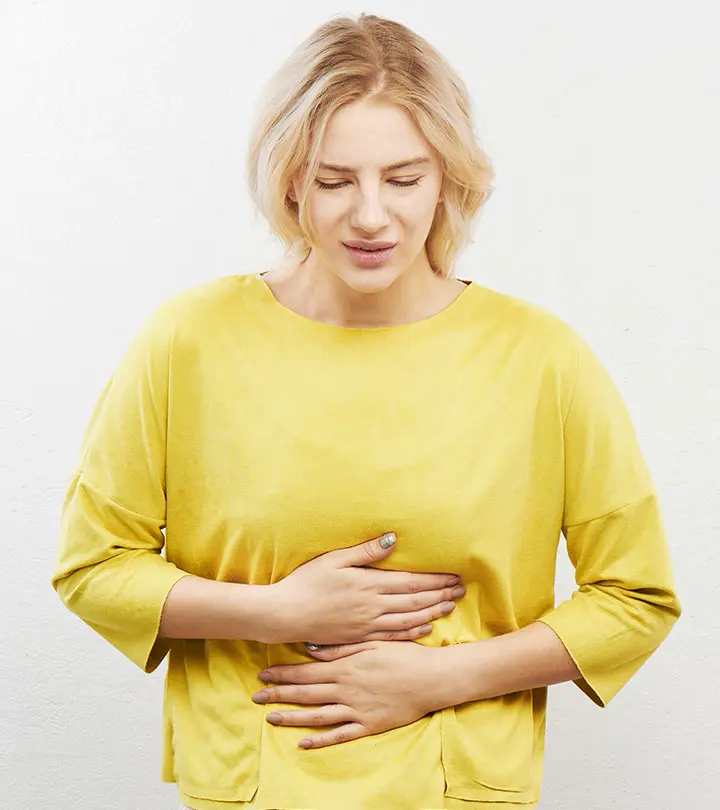




Community Experiences
Join the conversation and become a part of our empowering community! Share your stories, experiences, and insights to connect with other beauty, lifestyle, and health enthusiasts.